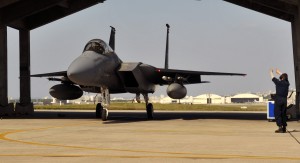2013-12-05 The USAF and the USMC are clearly working more closely together in shaping scalable expeditionary forces in the Pacific and elsewhere.
And the two services will be deploying F-35s in Japan in the next few years along with the Japanese, which will allow them to work through further innovations in terms of expeditionary approaches.
And of course, both services fly Ospreys.
In the Forager Fury II exercise, the USAF is bringing assets to the USMC led expeditionary exercise.

According to an article by Naoto Anazawa of the 18th Wing Public Affairs:
12/2/2013 – KADENA AIR BASE, Japan –
Approximately 40 Kadena Airmen deployed Nov. 26, with more than 240 airmen following them Nov. 30, to Andersen Air Base, Guam to support the Marine Corps-led Forager Fury II exercise Airmen from the 44th Fighter Squadron, 961st Airborne Air Control Squadron, 909th Air Refueling Squadron, 18th Logistic Readiness Squadron and 18th Force Support Squadron will support the exercise; joining Marines from Marine Corps Air Stations Futenma and Iwakuni, Japan, and MCAS Miramar, located in California.
Forager Fury II is scheduled to take place Dec. 2 to 20 on Andersen, Tinian’s West and North Fields, and the Farallon De Medinilla Target Range. FF II is firmly grounded in the successes and lessons learned from prior exercises conducted in the Mariana lsland Range Complex; and, provides an excellent opportunity for Air Force pilots to integrate with Marine pilots and work on their defensive and offensive counter air basic flight maneuvers.
“It’s important for us to go out and practice our expeditionary skills, deploy as a squadron and go out together to learn to deploy with the airplanes as well as work in other places,” said Capt. Aaron Osborne, 44th Fighter Squadron F-15 Eagle pilot. “This is a joint exercise so we can learn to interoperate between services. That’s really important to us to get practice doing that.”
Approximately 120 maintainers will be deploying from the 44th Aircraft Maintenance Unit and another 41 from various maintenance shops on Kadena.
“This exercise has a great deal of importance, particularly with us flying with the Marines, the integration between us and them. We don’t often get interaction as far as flying and coordination,” said Staff Sgt. Vincent Slupecki, 18th AMU avionics specialist. “I think it’ll be a good opportunity to show our skillset and feed off each other, learn different techniques.”
Training on Tinian and Guam will incorporate a variety of U.S. Marine fixed wing, rotor wing, and tiltrotor aircraft. Participating U.S. Marine Corps aircraft will include FA-18 Hornets, EA-6B Prowler, KC-130J Hercules in addition to the Air Force F-15 Eagles.

